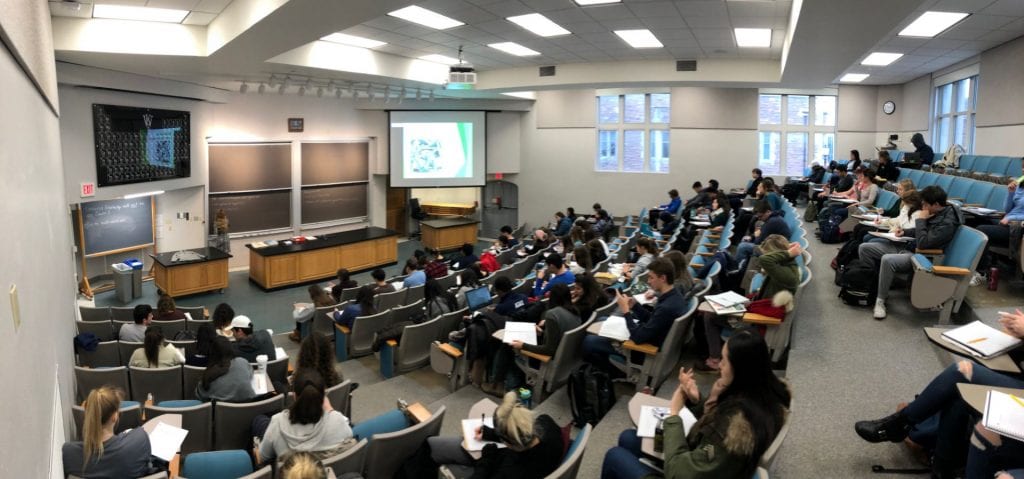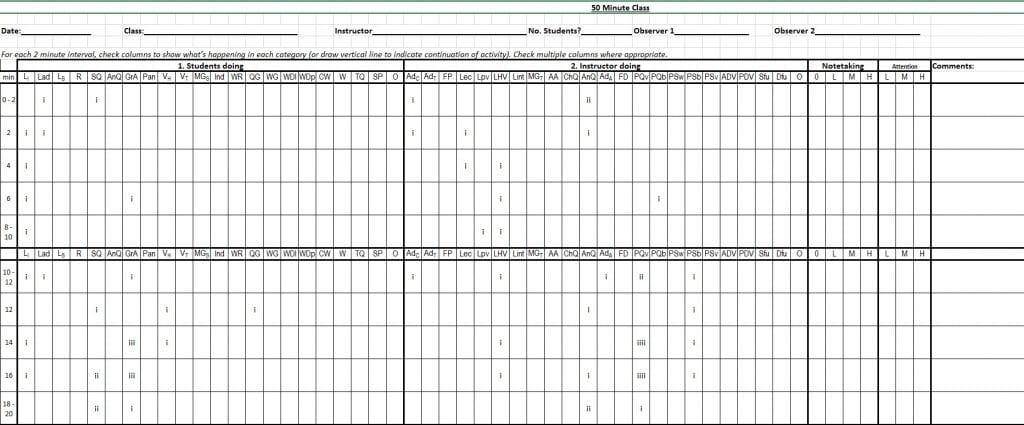OPAL: A Tool for Reflective Teaching
To provide instructors with a “big picture” view of what is happening in a class, collaborators from The Teaching Center and CIRCLE have recently developed a new classroom observation tool, the Observation Protocol for Active Learning (OPAL). We have designed OPAL to be applicable in a variety of courses, disciplines, and pedagogical strategies. To help faculty close the gap between what they remember about the class session and the actual, documented integration of active learning in their courses, OPAL tracks coded activities to provide instructors with a picture of what is happening—and when it is happening—during the observed class period.
Accessing the OPAL Tool
Faculty or researchers interested in using OPAL can access the tool in a few ways:
- Information about OPAL may be found in the Supplemental Materials (PDF) prepared for our 2016 Journal of College Science Teaching article (Frey, et al., 2016; see references below). These materials include Part I: Examples of Suggested Instructional Changes Resulting from Discussion of OPAL Timelines and Part II: Development of the Observation Protocol for Active Learning (OPAL). Part II also contains information on the development of OPAL and OPAL timelines, the training OPAL observers, and a full listing of all OPAL codes. For paper-based administration, the OPAL Codes (PDF) and Opal Data Collection Spreadsheet (XLSX) are linked here.*
- OPAL can also be found electronically on the General Observation and Reflection Platform (GORP) through the Tools for Evidence-based Action (TEA) group at the University of California, Davis. For more information on GORP, please visit the TEA website.
- Dylan Jew, a Washington University undergraduate student in Computer Science and Engineering, developed an OPAL ipad application. The OPAL ipad app is free to use. To download it, please contact Angela Fink, Research Scientist and Project Manager, CIRCLE.*
*Please note: The OPAL Codes and Data Collection sheets are adapted, in part, from TDOP and COPUS (Hora, 2013 and Smith, et al., 2013).
Integrating OPAL
With the initial support of AAU and a POD Network grant, we are integrating the use of OPAL into a Multi-Modal Observation for Scholarly Teaching (MOST)—which combines review and discussion of 1) a video-recorded class 2) feedback and suggestions from a Teaching Center staff member 3) an OPAL timeline displaying observational data from the recorded class. We believe that instructors take from the MOST consultation not only a clearer vision of their own teaching before and after they make a change, but also observational and critical skills that they can then apply to reflect on their own teaching or to observe a colleague. As instructors learn to see their teaching in a new way, they also learn ways of seeing that they can apply to the practice of scholarly teaching more broadly.
References
Fisher, B.A., Frey, R.F. (2015). Using documentary tools to foster the practice of scholarly teaching. The National Teaching and Learning Forum, 24(2), 4-6. (invited submission)
Frey, R. F., Fisher, B.A., Solomon, E.D., Leonard, D.A., Mutambuki, J.M , Cohen, C.A., Luo, J., & Pondugula, S. (2016). A visual approach to helping instructors integrate, document, and refine active learning. Journal of College Science Teaching, Vol. 45 (5), 20-26.
Hora, M. T. (2013). Exploring the use of the Teaching Dimensions Observation Protocol to develop fine-grained measures of interactive teaching in undergraduate science classrooms. University of Wisconsin–Madison, Wisconsin Center for Education Working Paper 2013-6.
Smith, M. K., Jones, F. H., Gilbert, S. L., & Wieman, C. E. (2013). The Classroom Observation Protocol for Undergraduate STEM (COPUS): a new instrument to characterize university STEM classroom practices. CBE-Life Sciences Education, 12(4), 618-627.
Solomon, E. D., Repice, M. D., Mutambuki, J. M., Leonard, D. A., Cohen, C. A., Luo, J., & Frey, R. F. (in press). A mixed method investigation of clicker implementation styles in STEM. CBE-Life Sciences Education.

